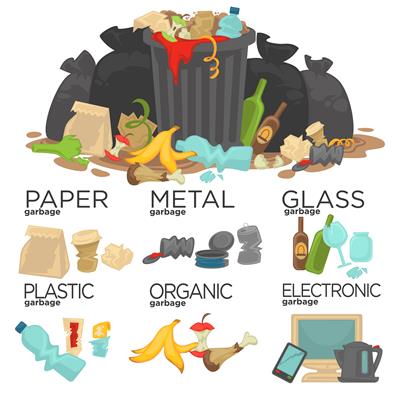PDF chapter test TRY NOW
What happens when you eat a packet of chips and then throw the empty packet away? Where does the empty packet go? What happens to it after we dispose of them? Think about the consequences of the garbage generated.
Our day-to-day activities generate a lot of waste in the form of garbage thrown away. The accumulation of wastes resulting from improper disposal is a major issue in our country.

Different kinds of waste
Population in our country has been growing at an alarming rate. Thus, there is a massive rise in the amount of waste generated, particularly in cities.
Do you know how much waste does an average person generate?
On average, each person generates 400 to 500 grams of garbage per day. At this rate, 500 tonnes of rubbish are created per day in a city of around 10 lakh people. To comprehend the problem and work towards a solution, one must first understand the waste produced.
Classification of wastes:
1. Biodegradable wastes
2. Non-biodegradable wastes
Biodegradable wastes:
Biodegradable wastes can be naturally broken down, decomposed and disposed of by saprophytes or decomposers. Common saprophytes include microscopic organisms or microbes, mainly bacteria and fungi. The microorganisms secrete enzymes that solubilize or degrades the waste to simpler substances.
Biodegradable wastes include organic wastes such as sewage and livestock waste, used tea leaves, waste paper, waste cotton, wool, leather, wood, jute articles, food leftovers, etc. The wastes can be disposed of at waste treatment plants or converted into agricultural resources such as manure and compost.

Biodegradable wastes
The biodegradable wastes should not be piled up anywhere, as they start decomposing to emit foul gases. They also attract many organisms (cockroaches, flies and mosquitoes), which may cause and spread various diseases. They become the breeding centres for flies, rodents and mosquitoes.

A pile of garbage emitting foul smell
Non-biodegradable wastes:
Non-biodegradable wastes are wastes that the decomposers cannot break down as they lack the enzyme to degrade them. These wastes are man-made and thus cannot be degraded. Removing non-biodegradable materials becomes problematic as it does not decay, and produces poisonous gases when burnt.
Examples of non-biodegradable wastes include plastic items, crockery, metallic cans, glass articles, polythene bags, synthetic fibres, silver foil, and numerous pesticides like BHC (Benzene hexachloride) and DDT.

Non-biodegradable wastes
Industries also generate several non-biodegradable wastes that include heavy metals, synthetic chemicals, toxins etc. Some of these wastes can be broken down by applying heat, pressure, and oxidation under specific conditions.
Reference:
https://pixabay.com/photos/plastic-bottles-bottles-recycling-115074/
